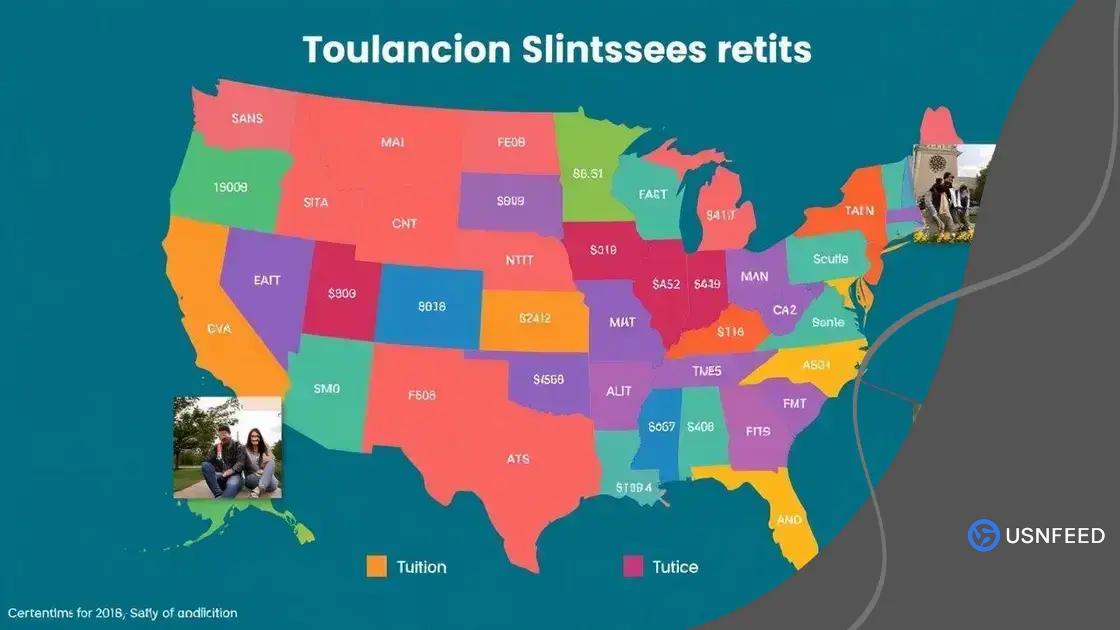College tuition costs trends USA: what to expect

College tuition costs trends in the USA show a steady increase, influenced by rising operational expenses, declining state funding, and growing competition for financial aid, making it crucial for students to stay informed about future pricing and funding options.
College tuition costs trends USA have been a hot topic in recent years, with many wondering how these changes impact future students. Are we witnessing a permanent shift in affordability? Let’s dive in and explore.
Current average tuition rates in the USA
The topic of current average tuition rates in the USA is crucial for potential students and their families. Understanding these figures helps make informed decisions about higher education choices.
Average Tuition Costs
As of the latest reports, the average tuition for a public four-year institution in the USA is approximately $10,000 for in-state students, while out-of-state students face an average of around $27,000. Private institutions usually have a higher price tag, averaging around $36,000 per year.
Comparative Analysis
When examining tuition costs across different types of institutions, a notable pattern emerges:
- Community colleges offer significantly lower tuition, often under $5,000 per year.
- Public universities typically charge lower rates for in-state residents.
- Private colleges often provide substantial financial aid packages to offset costs.
Over the years, tuition rates have increased steadily. This upward trend can be partly attributed to rising operational costs and declining state funding for public colleges. Consequently, students and families are sometimes left grappling with higher debts. It’s essential to explore financial aid options, including scholarships and grants, which can significantly alleviate the financial burden.
Additionally, regional differences play a role in tuition rates. States with higher costs of living may have more expensive universities, which is something to consider when choosing where to apply. In contrast, many local community colleges remain affordable and provide an excellent stepping stone into higher education.
In conclusion, understanding current average tuition rates in the USA can aid students in making wiser educational investments. Staying informed about these trends not only prepares students financially but also ensures they can navigate the complex landscape of college financing effectively.
Factors driving tuition increases
There are several key factors driving tuition increases in the United States that affect students today. Understanding these factors can help families better plan for the costs of higher education.
Rising Operational Costs
One significant factor is the rising operational costs for colleges and universities. Facilities maintenance, technology updates, and faculty salaries have all increased over the years. Institutions must keep up with these expenses, which often translate into higher tuition fees.
Declining State Funding
Another vital aspect is the decline in state funding for public universities, which has been noticeable over the past few decades. As states reduce their budget allocations for higher education, universities often increase tuition to compensate for these lost funds.
- State support has decreased by significant percentages in many areas.
- Public institutions face financial pressures as they try to maintain quality.
- Many states have shifted more educational costs to students and families.
Additionally, demand for higher education continues to rise. More high school graduates are seeking college degrees, which places additional strain on resources. When more students apply, colleges must invest in new facilities, staff, and programs to accommodate them. This increased demand can lead to tuition hikes as institutions try to provide necessary services.
Furthermore, inflation plays a role in tuition increases. Just like other goods and services, education costs rise over time, reflecting general economic trends. Colleges must adjust their pricing to keep up with the overall cost of living, which affects prospective students.
Institutional Choices
Many institutions also pursue initiatives that require additional funding, such as enhancing student services or initiating new programs. These efforts can be beneficial for students but often come at an increased cost. Schools may invest in cutting-edge technologies or capitalize on marketing to enhance their reputation, further influencing tuition rates.
Ultimately, tuition increases result from a complex interplay of these and other factors. As students navigate the educational landscape, being aware of these drivers can help them make informed decisions about their futures.
State-by-state tuition cost comparisons

Understanding state-by-state tuition cost comparisons is essential for students and families as they make college decisions. Different states have varying prices for tuition, which significantly affects students’ final expenses.
Average Tuition Costs by State
In the United States, the average tuition rates can greatly differ depending on the state. For instance, some of the lowest average tuition fees are found in states like Wyoming, where rates can be as low as $5,000 for in-state students. In contrast, states like California and New York tend to have higher average costs, often exceeding $10,000 yearly for public universities.
Factors Influencing Costs
Several factors contribute to these variations:
- The level of state funding for higher education impacts tuition rates.
- Cost of living in each state affects overall expenses for students.
- Institutional policies regarding financial aid can vary widely.
Moreover, states also have differing policies about community college pricing. In states like California, community colleges offer affordable tuition rates that attract many students seeking to save money before transferring to a university. On the other hand, some states may not have the same level of support, leading to higher community college fees.
Another interesting trend is that some regional areas may offer unique scholarships or financial assistance programs that affect tuition costs. Students should investigate these opportunities when considering colleges in different states. By comparing tuition costs across state lines, students can make more informed choices and perhaps save significantly on their education expenses.
Financial aid trends and implications
Exploring financial aid trends and implications can help students and families understand how to manage the costs of higher education effectively. Over the years, the landscape of financial aid has shifted, reflecting changes in policy, funding, and student needs.
Types of Financial Aid
Financial aid typically comes in three main forms: grants, loans, and scholarships. Grants are often need-based and do not require repayment. Scholarships can be merit-based or need-based, providing funds that students typically do not have to pay back. Loans, on the other hand, must be repaid, sometimes with interest, depending on the type of loan.
Increased Competition for Aid
As college tuition continues to rise, more students are applying for financial aid than ever before. This increase in competition can make it more challenging for some students to secure the funds they need. According to recent statistics, FAFSA applications have seen a steady rise, indicating a growing reliance on financial aid as a means to afford college.
- More students are applying for federal and state financial aid.
- Increased demand has led to crowded scholarship opportunities.
- Many colleges are adjusting financial aid packages to attract and retain students.
Moreover, COVID-19 has caused some changes in how financial aid is administered. Many schools have increased their emergency grant funding for students facing financial hardships due to the pandemic. These changes reflect the realities students face and aim to support them in navigating their education.
Understanding financial aid trends also includes being informed about potential changes in government policies. Shifts in federal funding can influence the availability and amount of aid students receive. Therefore, staying aware of these trends is vital for anyone considering higher education.
Future predictions for tuition rates
Future predictions for tuition rates indicate that students and families may continue to face challenges in affording higher education. Experts argue that the rising trend in tuition is likely to persist, driven by various economic and demographic factors.
Expected Increases
Many analysts forecast that college tuition will increase at a rate higher than inflation. This means that students may need to budget more for their education expenses each year. Some projections suggest that by 2030, average tuition at public universities could rise to over $15,000 for in-state students and even higher for out-of-state students.
Impact of Technological Changes
Technology also plays a significant role in shaping future tuition rates. As online education becomes more common, institutions may experiment with pricing models. Some colleges are exploring hybrid classes, where students pay less for online courses compared to traditional in-person classes.
- The adoption of technology could lead to lower overhead costs for universities.
- Online programs may provide alternatives for cost-conscious students.
- Financial aid may adapt to accommodate different types of learning environments.
Moreover, demographic shifts in enrollment can impact tuition rates. Fewer high school graduates may lead colleges to lower prices to attract students. Conversely, if demand remains high, institutions may retain or increase their tuition costs.
In addition to these trends, state funding levels will continue to play a crucial role in tuition pricing. States must balance budgets, and further cuts to higher education spending could lead public institutions to increase tuition to make up for lost revenues.
Given these factors, students should prepare for the likelihood of rising tuition costs in the future. Staying informed and exploring various educational funding options can help navigate potential financial challenges.
In summary, understanding the trends and factors affecting college tuition is essential for students and families. As tuition rates are expected to continue rising, it is important to stay informed about financial aid options and future predictions. By planning ahead and exploring various funding opportunities, students can navigate the costs of higher education more effectively. Knowledge is key to making smart decisions about college and securing a brighter future.
FAQ – Frequently Asked Questions about College Tuition Costs Trends
What are the current average tuition rates in the USA?
The current average tuition is approximately $10,000 for in-state public universities and around $27,000 for out-of-state students.
What factors are driving tuition increases?
Rising operational costs, declining state funding, and increased demand for higher education all contribute to tuition increases.
How does financial aid affect college affordability?
Financial aid helps offset tuition costs, but with increasing applications, competition for aid can make it challenging for some students.
What are the future predictions for tuition rates?
Experts predict that tuition rates will continue to rise, potentially exceeding $15,000 for public universities by 2030.